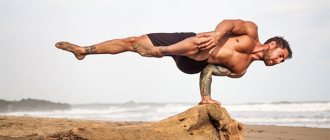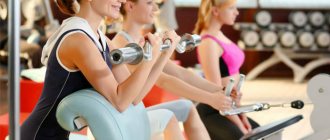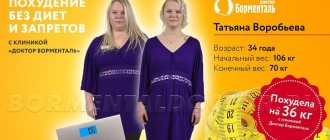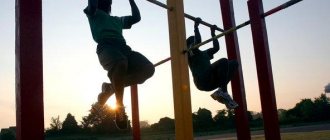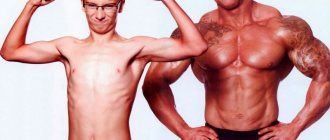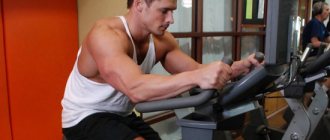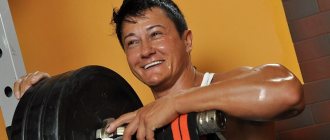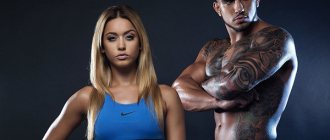Body-building
(from the English bodybuilding - body building) - the process of modifying the body, mainly due to muscle hypertrophy and reduction of subcutaneous fat, through weight lifting or strength training, high-calorie nutrition, sports dietary supplements, steroid hormones and other anabolic agents. An integral part of bodybuilding is the formation of relief; for this purpose, aerobic training, fat burners, diuretics are included in the training program, and special creams, oils and lotions are also used. Inherent characteristics of modern bodybuilding are also aesthetics, harmony and fortitude.
A person who engages in bodybuilding is called a bodybuilder or bodybuilder.
Evgeniy Sandov is considered the founder of bodybuilding. In 1901, he organized the first athletic beauty contest. Many athletes practiced according to a system of exercises specially developed by him. Sandow was considered one of the strongest people in the world - for example, his chest supported the weight of three horses, and with one hand he lifted a barbell, at the ends of which one adult man sat.
Competitive bodybuilding
- a sport where judges, based on the aesthetics, volume and quality of physical development of bodybuilders, demonstrating them by posing, determine the best bodybuilder.
The men's classic bodybuilding competition includes three rounds. In the first qualifying round, you must show mandatory poses. These are double biceps on the front, lats on the front, chest on the side, double biceps on the back, lats on the back, triceps on the side and abs. In the second round, athletes perform a free program. The final includes both compulsory and free posing.
Types of bodybuilding
Bodybuilding as an independent sport is divided into two areas:
- amateur;
- professional.
Amateurs are far from beginners in bodybuilding, who train occasionally. These are those athletes who are professionally engaged in bodybuilding, invest their finances in preparation for competitions, but if they win tournaments, they do not win valuable prizes.
Only those athletes who participate in international competitions and have good popularity and reputation can be called professionals. After a demonstration performance at the competition, these athletes are given not only the title, but also a PRO CARD. Professional bodybuilders primarily make money from their hobby: they perform at commercial tournaments, pose for glossy magazines, represent and advertise companies that produce sports nutrition, equipment, and clothing.
Types of bodybuilding ///
Professional bodybuilding
In the modern bodybuilding industry, a professional is usually defined as a bodybuilder who has won qualifying competitions as an amateur and earned a "Pro Card" from the IFBB. Holders of this card receive the right to compete in professional tournaments, for example, the Arnold Classic and the Night of Champions. In turn, the high results shown in such competitions give them the opportunity to participate in the Mr. Olympia competition. The title "Mr. Olympia" is the highest award in the field of professional bodybuilding.
Bodybuilding “without chemicals”
There are also organizations that promote so-called “natural” bodybuilding. These include:
- North American Natural Bodybuilding Federation (NANBF);
- "The International Natural Bodybuilding & Fitness Federation" (INBFF);
- Australasian Natural Bodybuilding Association (ANBA);
- International Natural Bodybuilding Association (INBA);
- Natural Physique Association (NPD);
These associations promote bodybuilding without the use of anabolic steroids and pharmacological agents. Adherents of “chemical-free” bodybuilding believe that their method is more focused on a healthy lifestyle and natural competition.
Female bodybuilding
The first American Women's National Phisique Championship was held in Canton, Ohio in 1978 thanks to Henry McGee. This was the world's first women's competition where participants were judged solely on their muscles. Since then, many women's competitions have been held, the most prestigious of which is Miss Olympia. The first winner of the competition, held in 1980, was Rachel McLeish.
Men's disciplines in bodybuilding
Competitions are held in age and weight categories. According to the age:
- Juniors (under 23 years old);
- General category (from 23 to 40 years old);
- Veterans (40-50 years old, 50-60 years old, 60 and older).
Categories are divided by weight every 10-15 kg, for example, bodybuilders weighing up to 75 kg, up to 90, etc. At the same time, muscle volume is assessed, how harmoniously the body is built, what is the percentage of fat tissue, symmetry. The judges pay attention to body proportions and how aesthetically pleasing the athlete’s figure looks.
The most spectacular are the competitions of “mass monsters” – bodybuilders weighing over 100 kg. These athletes are always professionals in their field, and not ordinary observers at tournaments or gym visitors. To achieve such relief, you need to train a lot and hard, eat mainly protein foods, and use steroids.
Increasingly, athletes prefer the discipline of Men's Physique ("Beach Bodybuilding"), but some do not like it because they have to style their hair and touch up before the performance. Such bodybuilders greatly influenced the popularization of bodybuilding not only in Russia, but throughout the world. They are the standard of male beauty and sexuality in many countries. Representatives of the Mens Physicist category work mainly on the “arms-shoulders” proportion. Legs are not so important, because they perform in shorts. This discipline is good for beginner athletes, but it is easy to switch from it to classical or heavyweight.
The golden mean is Classic bodybuilding. These are “beachers” who have gained good mass and worked on their legs. “Classical athletes” are of the opinion that working out the legs is mandatory in bodybuilding. They justify their position by the fact that this process is much more difficult than working with the torso and arms, where genetics plays a leading role and does not require much perseverance in the gym.
Growth categories
- — height up to 170 cm. Calculated using a certain formula: Participant’s height (cm) – 100 (+ 0 kg) = his possible maximum weight (kg). For example, if an athlete is 170 cm tall, then his possible maximum weight for this category will be 70 kg;
- - height up to 174 cm. It is calculated using a similar formula, only in this case we subtract 98 from the height value in cm (height - 100 (+2 kg)). Thus, an athlete with a height of 172 cm can have a maximum weight of 74 kg.
- - height up to 178 cm. In this category, we subtract 97 from the height value (height - 100 (+3 kg)), which results in a participant with a height of 175 cm, the maximum weight can be 78 kg.
- - height over 178 cm. Here the formula looks like this: height - 100 (+4 kg).
- - height over 180 cm.
- - height above 184 cm.
Mens Physicist speech template:
- Preliminary judging: TOP-15 selected
- Semi-final: TOP-6 selected
- The final
Women's disciplines
Until recently, a female bodybuilder looked like a pumped-up model. But female bodybuilding has continuously developed, enjoyed success among the fair half of humanity, and the modern female bodybuilder outwardly resembles a slightly masculine, withered figure.
This appearance is not given by nature, so girls take steroids, like some guys. Hormonal supplements in food are not a mandatory element - it is the choice of each athlete. Most condemn this decision because they understand the risk to health, especially women's.
The classic discipline is “Body Fitness”. Particular attention is paid to working out the muscles of the back, shoulders, and abs. At the same time, there should be a narrow waist and expressive legs. Women's bodybuilding is also divided into subcategories by height (in centimeters):
- up to 158;
- up to 163;
- up to 168;
- over 168.
Changes are periodically made to this course. Athletes either gain weight or, on the contrary, lose weight and become dry. The standards are about the same as in fitness, but acrobatic training is not required.
If a woman is involved in fitness, then at performances she shows gymnastic programs or dances, and not just poses. This discipline is quite difficult due to the high requirements for figure, gymnastic and acrobatic training. Nevertheless, practice shows that every girl can achieve results, and not only those who have been involved in rhythmic gymnastics since childhood; all you need is a lot of desire and perseverance.
The simplest discipline is “Bikini”, it is loved by many athletes involved in bodybuilding: there is no need to “dry” or gain large mass, the main focus is on working the buttocks, and the rest of the muscle corset is worked out minimally. However, at performances, not only the figure is assessed, but also external beauty: the condition of hair, nails, skin, image.
There is also the “Wellness” discipline, very similar to bikini, but athletes in this direction are larger than representatives of other trends in female bodybuilding, with well-pumped legs and buttocks. However, for classic female bodybuilding, athletes in this area have a weak upper muscle corset. Wellness is very popular in Brazil. Another branch of female bodybuilding is “Fitmodel”. These girls look like ordinary gym goers, their muscles are poorly developed, but on stage they compete mostly in fashion shows in evening dresses.
Features of natural bodybuilding
Natural bodybuilding is ideal for those people who want to get in shape not to make money from their body, and not for competitions. A distinctive feature of this discipline is a strict ban on the use of steroids by athletes. In the USA, natural bodybuilding is at the peak of its popularity.
It is worth noting that not everyone believes that you can create an athletic figure without hormones. Nevertheless, many athletes prove from their own experience that a long history of visiting the gym, hard training, good health and genetics will definitely give their results. This journey is much longer than the average bodybuilder on steroids. Of course, it is unlikely that a natural bodybuilder will be able to become a “mass monster”, since such a figure is unnatural for the human body.
Classic bodybuilding or Mens Physicist: which is better?
Opinions on this matter are divided between professionals and amateurs.
Some believe that posing in shorts is a desire to hide an imbalance in the figure. Others advocate for aesthetics and argue that compared to bodybuilders who show off mountains of muscle, moderately inflated bodies look natural. It cannot be denied that preparation for a “beach” competition takes place in a gentle manner and does not require such material costs as for bodybuilders. The absence of strict limits allows you to avoid training with critical weights, which have a detrimental effect on your health. Sources
- https://www.izhpromo.ru/2014/12/011220143/
- https://ProTvoySport.ru/mens-fizik-programma-trenirovok/
- https://fb.ru/article/459225/trenirovki-mens-fizik-raspisanie-zanyatiy-vidyi-uprajneniy-i-pravila-pitaniya
- https://mens-physics.ru/
- https://mens-physic.ru/pravila-mens-fizik.html
- https://bodybuilding-and-fitness.ru/atlety/mens-physique
- https://builderbody.ru/mens-fizik-plyazhnyj-bodibilding/
- https://builderbody.ru/programma-trenirovok-mens-fizik/
- https://force-man.ru/trenirovki/101-programma-trenirovok-mens-fizik-kak-kachayutsya-plyazhniki.html
- https://force-man.ru/interesno/120-kakimi-dolzhny-byt-proporcii-tela-mens-fizik.html
The benefits and harms of bodybuilding
Bodybuilding is deservedly considered the embodiment of a healthy lifestyle. This is no coincidence, because it has a lot of advantages:
- motivates you to exercise regularly to see results;
- helps overcome stress and some health problems (for example, normalizes blood pressure, fights female osteoporosis);
- improves the functioning of the cardiovascular system if there is cardio training;
- preserves muscles, increases joint mobility even in adulthood;
- helps prevent household injuries;
- improves blood supply to the pelvic organs, which prevents the occurrence of diseases of the organs of this area;
- If you don’t go to extremes and don’t gain a lot of body weight, then bodybuilding is an excellent way to deal with back pain, especially with a sedentary lifestyle.
It may seem that bodybuilding is the perfect sport. But there are pitfalls here too:
- Steroid use. Those who decide to make money on their body, sooner or later begin to take steroids, which quickly help them get into the ideal shape they need for competitions. Modern bodybuilders publish books and magazines and maintain Internet resources in which they educate athletes on how to properly take these drugs to “pump up” the body.
- "Drying". This is a kind of diet, thanks to which fat deposits go away, but muscles remain. On the one hand, it seems that what’s wrong with this? However, healthy fat is necessary for the proper functioning of the human body; you cannot deprive yourself of this component completely, as “dried” bodybuilders do. Also, this process is often reflected in the form of problems with the heart, blood vessels and kidneys.
- Injuries. Sooner or later, accidents happen to almost every bodybuilder in the gym.
A bodybuilder should remember that it is important to minimize the risk of injury, try to avoid it, and always be on guard.
Contraindications to bodybuilding
This type of sport is extremely undesirable for the following categories of people:
- People with chronic diseases of the kidneys, heart, liver. Heavy cardio and strength training can aggravate illnesses.
- Athletes with serious musculoskeletal injuries.
- People with metabolic disorders.
- Bodybuilding is not advisable for a person who has a history of diseases of the pituitary gland, hypothalamus, thyroid gland, or pancreas.
All these contraindications can be discussed with your doctor, because there have been famous diabetic bodybuilders and those who have problems with internal organs. If you practice bodybuilding at the fitness level without cutting, exhausting exercises and taking steroids, then these exercises will only improve your health.
It is strictly forbidden to train after receiving injuries and during the rehabilitation period, during an exacerbation of diseases, as well as during colds and flu.
Competition rules
Participants compete in several weight categories. As a rule, these are weights with limits of up to 65 kg, up to 70 kg, up to 80 kg, up to 90 kg and over 90 kg. The competition is divided into several days. On the first day, there is a demonstration of seven poses of the upper muscular corset: shoulders, arms, abs, back. The athlete has no more than 5 seconds to prepare the pose. The position is changed upon the judge's signal. If a participant takes a long time to prepare or changes his position earlier than expected, his score in the overall standings decreases.
On the second day, bodybuilders perform various exercises accompanied by music, and the overall impression and correct technique are assessed. Based on the results of the competition, the judges give scores and reward the winners.
Bodybuilding in mass culture ///
Many bodybuilders, during and after their career, begin to engage in various activities. Among the most popular professions among bodybuilders are actors, models, trainers, and strippers. Often the choice is made in favor of professions for which it is necessary to have beautiful external data or significant physical training. Today, many bodybuilders have achieved success outside of the competitive podium. In recent years, due to the spread of healthy lifestyle ideas, an amateur form of bodybuilding - fitness - has become popular. Bodybuilding is not only popular among young people; Today, competitions are held in different countries among various age categories, up to 80 years old. One of the most famous retired bodybuilders is the Japanese Tsutomu Tosaka.
Competition classification
All competitions are divided by type and status. By type they are classified into:
- Personal (applies to an individual athlete, he alone is awarded all points and awards).
- Individual-team (the competition is held between teams of bodybuilders who took 1st to 10th places and brought points for calculation to each group of participants).
At the end of the individual-team competition, three winning teams are determined and awarded titles and prizes.
Sadik Hadzovic
Sadik Hadzovic Wiki: https://en.wikipedia.org/wiki/Sadik_Hadzovic
Sadik Hadzovic is a huge name in Men's Physique right now and was winner of the 2015 Arnold Classic.
Not only that:
He was expected to challenge for 1st place at the 2015 Mr Olympia.
Sadik ended up finishing in 2nd place at the 2015 Mr Olympia Men's Physique competition behind Jeremy Buendia and subsequently announced he would be switching to the new bodybuilding division, Classic Physique, for future shows due to his size and natural ability to gain more muscle than Men's Physique would allow.
Despite his plans to switch to Classic Physique, Sadik has done amazing things to bring Men's Physique into the limelight, and due to his crazy genetics and humble mannerisms, he continues to be one of the divisions favored athletes by many around the world.
Sadik Hadzovic is sponsored by GAT Supplements and has recently been working to promote Body Engineers; the bodybuilding fashion brand from Tavi Castro.
If you're an Instagram user, you can check out Sadik Hadzovic on Instagram here.
References:
1: https://www.bodybuilding.com/fun/2015-ifbb-olympia-results-scorecards.html
2: Classic Physique announcement: https://www.instagram.com/p/9bJoe8Luk4/
Presentation on stage
In the first round, all bodybuilders, depending on weight and height categories, line up in order of assigned numbers. The judges mark the athletes' numbers. Then five participants simultaneously perform the required poses:
- showing front and back double biceps;
- biceps side;
- abs and thighs.
These positions are not evaluated, but are necessary for comparison and subsequent evaluation of seven poses for men, five poses for women:
- double biceps front and back view;
- side view of biceps;
- triceps side view;
- abs and thighs.
Additionally, the following male positions are present: back muscles in front and behind.
In the second round, participants who passed the evaluation on the first day of the competition perform a free program to musical accompaniment. The duration of the speech is no more than 1 minute. Then the bodybuilders are evaluated by judges, points are calculated and the winners are awarded.
Performance on stage is somewhat different for women involved in fitness and body fitness. In the first round, a free program is shown for the choice of contestants for 1.5 minutes. The judges appreciate the presence of acrobatic and gymnastic elements in the performances, the strength of movement, flexibility and artistry of the girls. The program involves demonstration of acrobatic and dance exercises. The costume for the performance is also evaluated by the judges; props, if any, must be agreed upon with the competition organizers.
In the second round, the athletes line up and alternately rotate around their axis by 90 degrees in 4 stages. This way the judges have the opportunity to evaluate the front, rear and side views. After the performance, experts must rank the participants in a special list according to the principle “from the best participant to the worst” (in their opinion). All assessments are recorded in a summary protocol. If a situation arises when all applicants have an equal score, use the comparison method.
Steve Cook
Steve Cook Wiki: https://en.wikipedia.org/wiki/Steve_Cook_(bodybuilder)
Steve Cook is sponsored by both Optimum Nutrition and Bodybuilding.com and quickly rose to fame after winning the 2010 Fit Body Competition and 2011 BodySpace Spokesmodel Search competitions on Bodybuilding.com itself.
The middle child of 7, Cook grew up in a very athletic family, with a father who was an Athletic Director at a local high school, so it's no surprise he found himself in the gym from an early age.
But:
Before competing in bodybuilding, he played four years of college football.
He states himself that during this time, he was unlike a lot of other football players because he was concerned with lifting weight under control, focusing on time under tension instead of simply just trying to lift as much weight as possible without poor form.
Despite ruling himself out of the 2015 Mr Olympia Men's Physique competition and having not competed for some time now, he is still one of the largest names in the sport with what some people describe as the perfect body for men's physique.
These days, Steve stands 6-foot-1 in height and when in shape holds around 212 pounds of well-conditioned muscle on a perfectly proportioned frame and is the definition of brilliant modern physique.
Cook's balanced physique and chiseled features have landed him many magazine covers. He's built a massive following across social media and has a popular YouTube channel. He calls his fans the “Swoldier Nation” and often responds to people's questions online. This dedication to fans separates Steve from the pack compared to others.
Steve began his competitive career as a heavyweight bodybuilder, but quickly discovered that his tall and symmetrical frame was better suited to physique competition.
Recently, he has launched his latest training program and workout guide, 'BIG', which is getting huge attention from around the fitness industry.
Performance evaluation system
Each jury member is based on the criteria for evaluating the participant in body proportion and symmetry, muscle balance. So, the judge places the contestants on the list, with the one who, in the expert’s opinion, should be the winner, in first place, and then in descending order of points. After this, the scores of all judges are summed up, the arithmetic average is allocated and the bodybuilders are awarded prizes.
In the demonstrated poses, the jury member first evaluates the muscle group that is being emphasized, and only then evaluates the entire physique. It is important that there is relief, that the right and left sides, muscle density and volume are symmetrical. Each muscle group is taken into account: neck, chest, shoulders, arms, abs, waist, hips, calves, legs. If the pose is from behind, then the muscles of the back, buttocks, and back of the thighs are also assessed.
The jury values a harmonious appearance, when all muscles are equally pumped, there is beautiful posture, broad shoulders, a narrow waist, and body proportions are maintained. Judges reduce points for tattoos, skin rashes, unkempt hair, legs, hands and nails, and plastic surgery.
Athletes are graded on a ten-point scale, where the highest points - from 8 to 10 - are given for each position separately, and are summed up at the end of the competition.
Equipment
The costume for the competition must meet certain requirements. Men usually perform in neutral-colored swimming trunks. Swimming trunks made of brocade or lurex are prohibited.
Women perform in a two-piece swimsuit and high-heeled shoes. The color of the swimsuit can be any, the main thing is that the chest and half of the buttocks are covered; Thong swimsuits are strictly prohibited. In fitness, when demonstrating a free program, a dance costume is also implied, but there are no strict requirements for it.
Men's physicist beach bodybuilding
Pumped up “tanned” (read: made up) handsome men in bright colored shorts. Perhaps every girl's dream.
What are the specifics of this category?
- The muscles of the shoulder girdle, back, pectoral muscles, and abs are more developed in athletes.
- Smaller muscle volumes, unlike classic bodybuilding
- A thin waist is welcome
- They perform in bright beach shorts and choose colors based on their own wishes.
- Men's physicist can be recognized by his fashionable hairstyle, as if he had just left a barber shop
- No mandatory poses, free posing
- Characterized by naturalness and relief (but not absolute dryness)
Prohibited tricks
When an athlete is on stage, he is prohibited from:
- chew candy or gum;
- use doping;
- bring props that have not been approved by the competition organizer, as this may disrupt the order, require cleaning, or harm other participants in the competition.
When preparing for a performance, you should not use lotions with shiny particles or tanning creams that add shine to the skin. Regular “care” creams are allowed, but not body oils.
Admission to competitions
Only those bodybuilders approved by a special commission are allowed to perform. First of all, an application for participation must be submitted and a medical certificate stamped by a doctor must be provided. Only after a medical examination is the diagnosis given. The application for participation is sent to the federation or organizing committee by mail no later than three weeks before the competition. A certified application with a mark and seal from the doctor is submitted until the day of the performance.
Bodybuilders draw lots, after which they are assigned certain numbers under which they will perform and be listed on the lists of the judges. As soon as the admission committee completes its work, a meeting is held for the participants and jury members, at which detailed useful information about the performance is provided.
Judging system
A jury member is an impartial judge of the competition who is selected by the competition organizer to comply with the rules and regulations. The judge must be an expert in the sport and must have been trained and qualified before the competition.
The full composition of the jury is approved by the federation or also by the organizer of the event. The main panel of judges consists of:
- chief judge (controls all members of the jury, it is his opinion that is decisive, he is responsible for maintaining order and regulations);
- deputy judge (follows the instructions of the chief judge, and if he is absent, then performs his direct duties);
- chief secretary (manages the work of the secretariat, controls document flow, calculates points);
- deputy secretary (replaces the chief secretary in his absence, prepares awards for the winners).
The chief judge resolves all conflict situations, checks the competition venue for compliance with fire safety rules, and inspects inventory and equipment. He has the right to decide to stop the athletes’ performance if an unforeseen situation occurs; makes changes to the competition schedule, removes jury members from judging if they do not fully fulfill their duties; at the end of the performances, announces the results, and can also impose sanctions on participants and coaches.
If the competition has an international format and a large scale, then there may be several deputy judges. The deputy monitors how sanitary and hygienic requirements are observed at the competition and provides technical specifications containing information on how to conduct performances. His responsibilities also include preparing the venue for performances: designing advertising, purchasing office supplies for judges, preparing the stage and utility rooms.
The chief secretary must be proficient in computer programs and prepare documents before the start of the competition for jury members and team representatives. The secretary also compiles a list of participants and the judging panel, prepares diplomas and awards for winners and prize-winners; controls the results produced by the computer and contacts the press center.
The panel of judges includes:
- Judge-commentator (announces poses during bodybuilders’ performances, if necessary, informs the public, conducts the award ceremony);
- Music judge (collects sources with musical accompaniment from team representatives, checks sound quality, controls the order of performances);
- A judge for the participants (responsible for drawing lots and awarding, assists doctors if injuries occur);
- A judge on the refereeing team (has the right to remove anyone from the team from duties if he does not comply with the rules or dress code).
Before the start of any competition, a meeting is held where technical issues are discussed and judges are appointed. Judges must wear clothing according to the dress code: gray trousers or skirt, white blouse or shirt, tie or scarf, and, if necessary, a blue jacket. It is mandatory to have a referee badge on the left side of the shirt or jacket.
Federation
The most popular bodybuilding federations in the world are:
- The IFBB is the largest international federation today that holds tournaments in the United States. In our country, the interests of this organization are represented by the FBI. The most famous competition from the IFBB is “Olympia” - a spectacular battle of “mass monsters”.
- NABBA is another international federation, but smaller and less well-known.
- WBFF is a high-status organization of an international format with a developed element of entertainment and show at tournaments. In women's disciplines, fancy costumes are allowed, and a fashion show in dresses is also a mandatory element.
- NBS is a federation on a Russian scale. It differs from the rest in open judging, payment of compensation for trips to international competitions, and the presence of a separate nomination for posing.
In addition to these, there are dozens of smaller organizations.
Jason Poston
Jason Poston Wiki: https://en.wikipedia.org/wiki/Jason_Poston
Jason Poston is an American IFBB professional physique competitor and fitness model.
A regular competitor, his most recent victory was in 2014 at IFBB Europa Phoenix.
Jason was the 2nd runner up at the 2014 Mr. Olympia physique showdown competition, finished in 3rd place at the 2015 Mr Olympia Men's Physique competition and achieved 3rd place again at the 2016 Arnold Classic.
A native of Dallas, Texas, Jason lost vision in one eye earlier in life due to a rare disease called keratoconus. Only a cornea transplant corrected this and Poston was able to see again, but that was not to be the last of his medical problems, as he would later be diagnosed with diabetes.
Always an athletic person, Poston played many sports as a teenager. It wasn't until he was 19 that he took up bodybuilding and it was in 2008 when he really started to focus on the iron game.
“I won the BSN Fitness Model Search at the Europa in Dallas (that year) and that motivated me to take the physique route with my body,” Poston fondly recalls. “I wanted to be signed by a supplement company and inspire others to live healthy lives.”
Competing in Men's Physique
Poston entered the 2011 Oklahoma City Grand Prix eight weeks after being properly diagnosed with diabetes and placed fifth.
Now that he was back and better then ever:
Poston signed up for the 2012 NPC Ronnie Coleman Classic and won the overall out of over 100 competitors which qualified him for nationals.
He placed eighth at the Junior Nationals in Chicago but earned his IFBB pro card at the USAs in Vegas a few months later. “My goal had been achieved even quicker than I thought,” says Poston, who placed a very respectable third in his IFBB Pro inaugural show at the Houston Pro 2012 just 3 months after earning his pro card.
He continued this momentum in 2013 to complete 6 more IFBB pro physique shows.
Based on his placings he qualified for the Olympia Mens Physique showdown where he placed fifth of the 17 competitors who qualified worldwide.
Poston is the only type 1 Diabetic to compete in the mens Olympia contest to date. His fifth place finish qualified him for the 2014 Olympia.
In 2015, Poston again competed in the Men's Physique division of the Mr Olympia contest, finishing 3rd overall.
At the 2016 Men's Physique Olympia, Jason looked a shade too big for the division and his placements suffered due to that.
He could be one of those we see switch over to Classic Physique in the coming years.
Jason Poston Instagram: https://instagram.com/jasonpostonpro/
History of bodybuilding
The best of the best competed at the Olympic Games - such performances were held in high esteem even at that time. Rumors and information about their winners were passed on from mouth to mouth, and some stories were even surrounded by myths. For example, there is a legend that Milon of Croton, in preparation for competitions, every day took on a bull and walked almost 200 meters with this load. The young bull grew and, accordingly, every day increased the load on the athlete’s muscles. Other contemporaries of the athlete claimed that he himself could move his statue to another city or carry a sacrificial bull through the stadium to the altar, slaughter the animal, cook and eat it whole in one sitting.
However, all these legends have a real historical background: Milo actually became the winner of the Olympic Games several times and introduced a system of preparation for competitions. It consisted of gradually increasing the load on the muscles using weights.
Unfortunately, weightlifting was not included in the list of competitions at the Olympic Games, but athletes competed in throwing huge stones and shot put. It seems incredible, but one of the stones weighing 143 kg has survived to this day in the Olympic Museum. There is an inscription on it that says that Bibok, who once lived, threw the boulder over his head with one hand. On ancient dishes and vases one can discern images of athletes who resemble modern weightlifters.
It is interesting to read the treatise “Preserving Health” from the ancient Roman physician Galen. The manuscript provides detailed instructions on how to develop strength muscles. Galen wrote his work back in the 2nd century for warriors and gladiators, but ordinary citizens also read it.
In the Middle Ages, interest in a fit, healthy body decreased somewhat, sports began to be banned everywhere, and they even stopped competing at the Olympic Games. This happened due to the increased influence of the Christian church, in which at that time any competitions were considered from the evil one as reminiscent of pagan rites. The first Christians called flaunting one's strength and power madness and vanity.
The degree of hatred for sports among Christian preachers decreased somewhat during the period of feudalism, when knights were trained for the Crusades. Then the training was carried out using strength exercises. However, athletics gained real popularity only at the beginning of the 20th century. A famous promoter of physical culture of that time was Evgeniy Sandov. He was not only a professor, but also a famous wrestler, performed in the circus, and wrote books on physical development. Sandow argued that to be healthy, a person must move - this is his nature. If there is no movement, the functioning of internal organs begins to fail.
Eugene had a perfect body and super strength. He could lift large heavy objects, animals, and people with his bare hands. Sandow described the principles of bodybuilding in his book “Bodybuilding.” The publication was published in 1903 in London and was quickly sold out by readers. Evgeniy especially emphasized that you should train with dumbbells, and the load should be increased gradually.
The author of another noteworthy system is the French athlete de Bonnet. The method contains 17 weight-bearing exercises, ending with stretching and relaxation training.
The next cult figure was Bernard McFadden. He also founded the first magazine in the United States dedicated to physical culture. Bernard also became the founder of an American competition where men competed based on physical characteristics. In Europe, the Englishman Angelo Siciliano was considered the best bodybuilder.
After the 20s of the 20th century, interest in bodybuilding faded again, but at the end of World War II it attracted the attention of Americans, who were “shaken” by the past global massacre. They realized that bodybuilding, like any other sport, is vital for developing strength and endurance. A cult of a strong, pumped-up man has appeared in American society. It turned out that it is bodybuilding with strength exercises and weights that gives a visible effect - a beautiful body and power.
Steve Reeves has won several Mr. Universe and Mr. America titles thanks to his athletic physique. He used these achievements for commercial purposes: he developed his own training technique, published many books, magazines and proved that bodybuilding can be a profitable sport. Steve's followers opened various schools for teaching bodybuilding, enterprises for the production of sports equipment for training. Gradually, a wave of passion for bodybuilding covered the whole world. In the second half of the last century, bodybuilding was divided into several movements.
This is how the bodybuilding that is known today appeared. The physical characteristics of athletes have become very important. The star of bodybuilding in the 60s was Arnold Schwarzenegger, whose name is still widely heard, because he is not just an athlete, but also a famous actor and political figure. Arnold acquired the last two of these incarnations largely due to his success in bodybuilding.
At the present stage, bodybuilding is an honorable and popular sport. Exercising with it helps to evenly develop the muscular corset of the body, and the huge advantage is that the follower gradually comes to lead a healthy lifestyle: he does strength exercises every day, refuses junk food, alcohol, cigarettes and drugs; The endurance of body and spirit increases, even outlook on life and character change.
Jeremy Buendia
Jeremy Buendia Wiki: https://en.wikipedia.org/wiki/Jeremy_Buendia
Jeremy Buendia won the 2014 Mr Olympia Men's Physique competition and successfully defended that title in 2015 finishing in 1st place at the Mr O once again.
He successfully managed the “3-peat” at the 2016 Men's Physique Olympia finishing in 1st place once again and is truly dominating the sport right now.
Previous to his victories, he was the first runner up (2nd Place) at the 2013 Mr. Olympia physique showdown competition.
Buendia got started in bodybuilding as his father was a non-competitive bodybuilder in the 70's, and grew up watching him workout every morning in the families home gym.
Love for the weights stayed with Jeremy through high school, where he became a standout linebacker at Whitney High and earned an all-league honors despite playing his senior season with a bulging disc in his neck and lower back.
A handful of colleges came calling for his services, but the injury and a desire to focus on getting an education meant the end of Jeremy's playing days and a larger focus on bodybuilding, where he first began competing at the age of 17.
Through this he would go on to win the Overall title in the Teen division at the 2010 Contra Costa Championships.
Jeremy's first win as an IFBB professional came at the Greater Gulf States Pro in 2013, after which he went on to place 2nd at the 2013 Olympia Weekend. Coming 2nd must have lit a fire in his belly, as he's placed 1st in every competition he has entered since then, winning the 2014 and 2015 Mr Olympia competitions along with the Sacremento Pro and San Jose Pro competitions.
Jeremy is sponsored by Evogen Nutrition and Live Fit Apparel and through his Evogen connection, works with the “Pro Creator” himself, Hany Rambod to develop his competition winning physique.
References:
1: https://www.evogennutrition.com/team-evogen/jeremy-buendia/
Books on bodybuilding
From the huge variety of specialized literature, we will present the top 3 best books for bodybuilders, which are undoubtedly interesting in the conditions of Russian realities.
- Kireev A.: “Culturism our way, or the secrets of the rocking chair.” The author explains and describes the exercises in detail. The manual contains unique features of the training process without unnecessary use of terms. All presented exercise techniques develop not only the muscular corset, but also willpower.
- Ostapenko L., Klestov M.: “Anabolic agents in modern strength sports.” It is a useful read for athletes who decide to use steroids. The book examines in detail the benefits and pitfalls of these “miracle remedies.” The publication is a must read for all bodybuilders.
- Protasenko V.: “Think! Or super training without misconceptions! The manual is based on other literary publications from Mentzer and Macrobert. Only the best methods and techniques that fit the Russian mentality were selected. This is a reference book for a bodybuilder, in which the athlete will find the necessary theories, exercises, and subtleties of preparation. The only negative is that there are not enough images.
The world of bodybuilding is multifaceted and very interesting, because new disciplines are constantly being identified and developed. More and more young people are interested in working out their figure not for the sake of competitions and earnings, but for the sake of health. Bodybuilding is unique in that every follower of this sport will definitely find a discipline to their liking.
